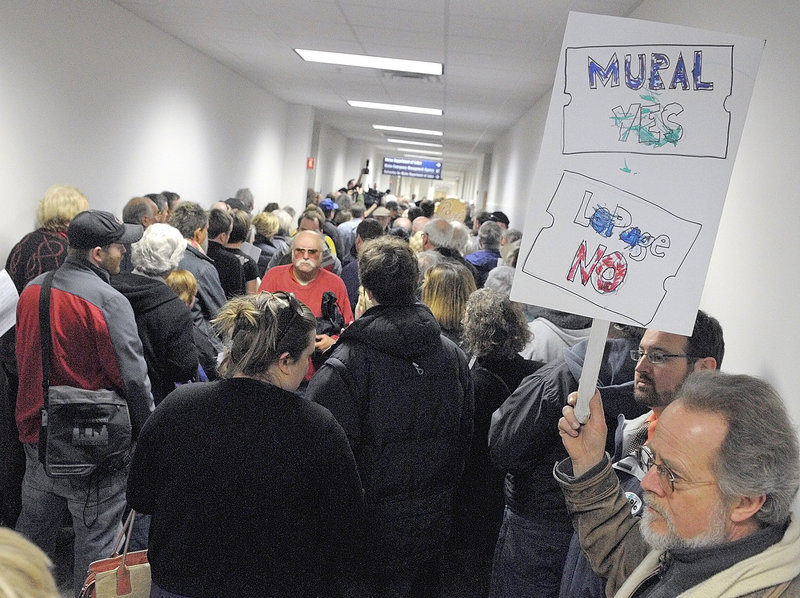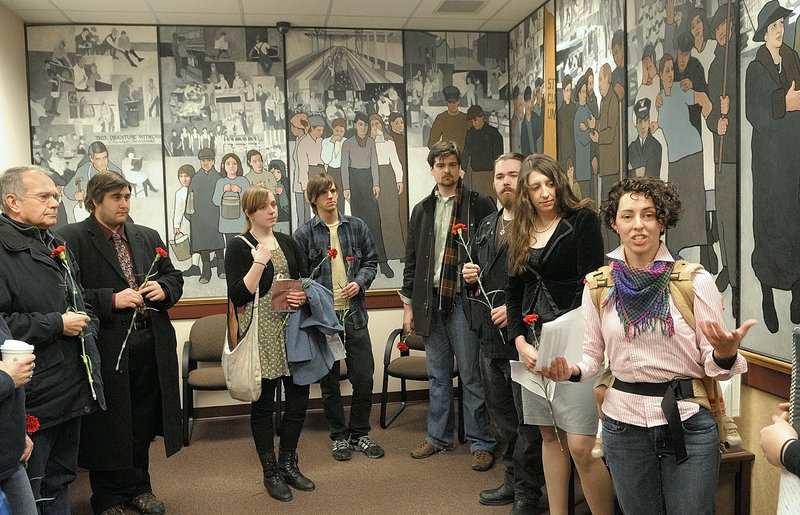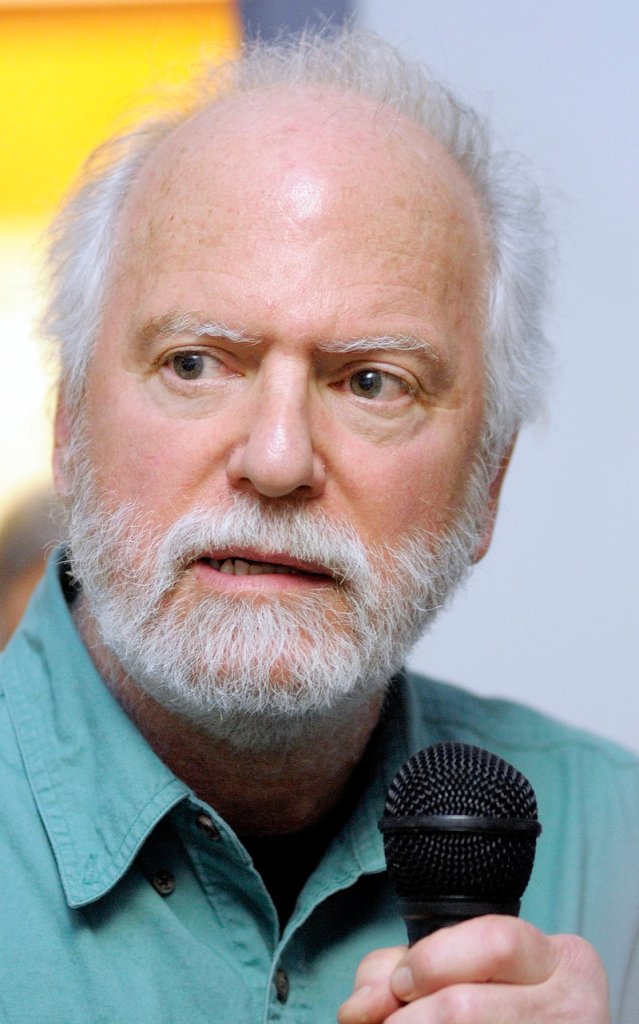AUGUSTA – Several hundred people packed a corridor in a state government building Friday to protest Gov. Paul LePage’s plan to remove a mural depicting Maine labor history from the Department of Labor’s headquarters.
The 36-foot-long mural is now in the building’s reception area, which was far too small to hold the crowd that turned out for the noon rally.
LePage gave the order to remove the mural after receiving complaints that it sends a one-sided, anti-employer message. He also ordered new names for conference rooms in the building that honor prominent figures in labor history.
Late Friday afternoon, LePage’s office announced a plan to lend the mural to Portland for display at City Hall. The proposal would have to be approved by city councilors.
Rob Shetterly, president of the Maine Union of Visual Artists, told the crowd that the painting depicts the history of Maine’s people. “It’s a history that gives us the courage to struggle for our own rights today,” he said.
The mural has 11 panels depicting scenes such as the celebration of the first Labor Day and the 1987 papermakers strike in Jay, as well as labor reformers including Frances Perkins, who was secretary of labor under President Franklin D. Roosevelt and had ties to Maine.
The mural, by Judy Taylor of Tremont, was installed in 2008.
Charlie Scontras, a labor historian who consulted with the artist on the project, said organized labor demanded the creation of a Labor Department to collect data that would spur legislation to create safer workplaces.
“Nothing is built without labor, including this Department of Labor,” he said.
Some in the crowd broke into chants during the hourlong rally, including “Recall Paul,” “Nazis banned art,” and “Who are we? The people. Whose mural? Ours.”
Seven speakers addressed the group during the event, organized by the Maine Union of Visual Artists and the Maine AFL-CIO.
The gathering also commemorated the 100th anniversary of the Triangle Shirtwaist factory fire in New York City, which killed 146 workers on March 25, 1911.
Some workers died after finding a stairwell locked, others were victims of a collapsing fire escape, and some jumped from the building to escape the blaze, said Mike Williams, a South Portland firefighter who is 2nd District vice president of the Professional Firefighters of Maine.
The work of Perkins — whose legacy is represented at the state Department of Labor in the mural and in a conference room — led to codes like requirements for sprinkler systems and occupancy regulations, Williams said.
“Now, by order of our governor, those tributes are to be cast aside, erased from history in a disappointing gesture that is only causing division among Maine people — an order that is being made under the guise of government being neutral to all parties,” he said.
The name of each of Triangle Shirtwaist victim was read aloud, followed by the ringing of a bell. The voice of Sarah Bigney, the AFL-CIO staffer who read the names, broke with emotion after she started the list. Tears streamed down her face by the time she reached the surnames starting with L.
The rally was the second on Friday to protest the removal of the mural and remember the Triangle Shirtwaist fire.
In the morning, a small group placed red carnations on a table by the mural’s panel depicting the 1937 strike at the Lewiston-Auburn shoe shops.
Jessica Graham, 28, a stay-at-home mother from Waterville, was one of three women who organized the morning event. She said a prayer asking God to “watch over those, both night and day, who work while others sleep, and grant that we may never forget that our common life depends on each other’s toil.”
Between the events, people came into the reception area to see the mural.
Among them was David Taylor, 76, of Boothbay Harbor, a retired electrician with the International Brotherhood of Electrical Workers. He said he was disgusted by the prospect of the mural’s removal.
“They even show a ballot box. That’s pretty controversial,” he said. “I see what the problem is: strikes, solidarity.”
Jerry Topinka, 66, a retired scientist from Boothbay Harbor, is not from a union background but said he was inspired by those who stood up for workers’ rights.
“The union legacy is a legacy that has contributed to every working man or woman, whether they’re union or not,” he said.
Staff Writer Ann S. Kim can be contacted at 791-6383 or at: akim@pressherald.com
Copy the Story Link
Send questions/comments to the editors.





Success. Please wait for the page to reload. If the page does not reload within 5 seconds, please refresh the page.
Enter your email and password to access comments.
Hi, to comment on stories you must . This profile is in addition to your subscription and website login.
Already have a commenting profile? .
Invalid username/password.
Please check your email to confirm and complete your registration.
Only subscribers are eligible to post comments. Please subscribe or login first for digital access. Here’s why.
Use the form below to reset your password. When you've submitted your account email, we will send an email with a reset code.